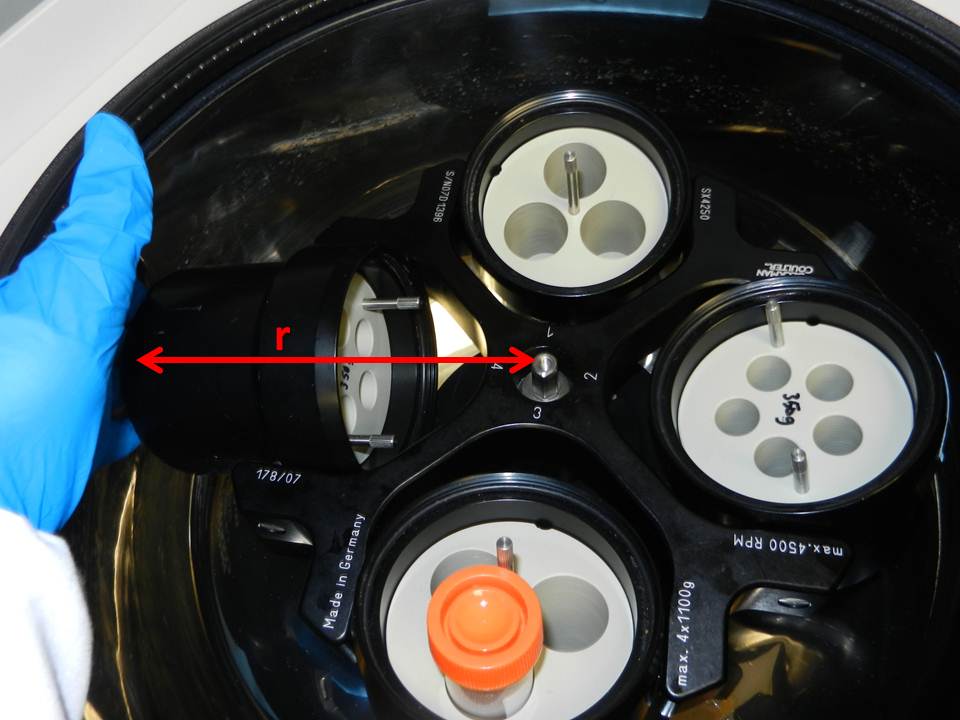
g Force or Relative Centrifugal Force (RCF) is the amount of acceleration to be applied to the sample. It depends on the revolutions per minute (RPM) and radius of the rotor, and is relative to the force of Earth’s gravity.
A good, precise protocol for centrifugation instructs you to use the g force rather than RPMs because the rotor size might differ, and g force will be different while the revolutions per minute stay the same. Unfortunately, many protocols are written in hurry and instructions are given in RPMs. Therefore, you have to convert g force (RCF) into revolutions per minute (rpms) and vice versa.
Modern centrifuges have an automatic converter but older ones do not. There is a simple formula to calculate this, but it takes some time to do the calculation. Meanwhile, your cells might die or the biochemical reaction goes on for three times longer than it should.
There are several ways to make conversion:
- Use a website where you can select centrifuge model and rotor head.
- Use online converters.
- Use a Nomogram (Nomograph).
- Make the calculation yourself.
1. The most precise way to make conversion is to use converters for a particular centrifuge and a rotor head. Companies provide the data. Here are the links to a resources online from where you can pick up the model and rotor:
Beckman, Sorvall or Thermo Fisher Scientific
Sorvall, Beckman and Eppendorf
Eppendorf
Science Gateway might list some centrifuges that are not found above.
2. Here are several links to converters online:
3. Print and use Nomogram (a graphical calculator). They are available from the following:
University of Maryland web site
4. The formula is always good to have in case your internet is down or the above links cease to exist.
g Force (RCF) = (rpm)2 × 1.118 × 10-5 × r
RPM = √[RCF/(r × 1.118)] × 1 × 105
g = Relative Centrifuge Force
r = rotational radius (cm)
N = Revolutions Per Minute (RPM)
I hope the above information will make your calculation easy.
Latest posts by Promega (see all)
- Overcoming qPCR Inhibitors: Strategies for Reliable Quantification - March 13, 2025
- Celebrating Creativity and Innovation: The 2025 Promega Employee Art Showcase - February 4, 2025
- Soft Skills for the Science Lab: Develop Yourself with Promega - November 14, 2024

Eppendorf AG Germany produces Centrifuges-both refrigerated ‘n’ non-refrigerated with a touch key pad that has a key which can change the RPM to RCF or vice versa with touch of the key. The product catalog has RPM/RCF conversion furmula with table and many valuable information on its index for Biotechnologists
Hi Rajan,
Thanks for the information. Please provide the link to that manual.
why mass is not considered in the formulae? If centrifugal force is mw^2r then why mass is not considered in g force.
Suppose i have a centrifuge machine for oil extraction. i’d assume the machine capacity is 250 kg/hr. I need to know whether mass/load has no role in it for selecting machine RPM
Here are two other posts that talk about the G Force calculation: https://clinfield.com/how-to-convert-centrifuge-rpm-to-rcf-or-g-force/ https://www.quora.com/What-is-a-g-force-and-how-does-it-apply-in-a-centrifuge
Thank you Nives for this information !
What does the 1.118 in the calculation represent?
You can find your answer to the calculation that generates that constant in the Wikipedia article providing the mathematical description for Centrifugation. https://en.wikipedia.org/wiki/Centrifuge